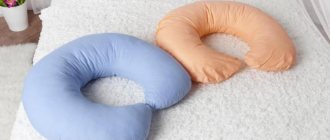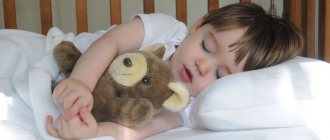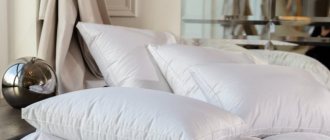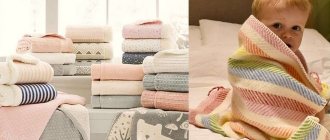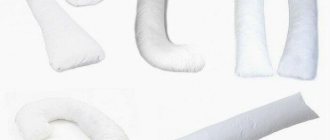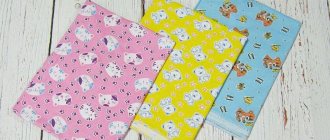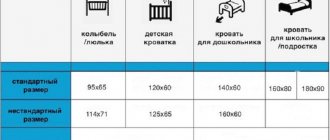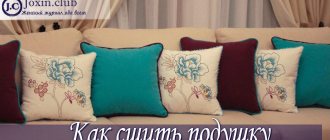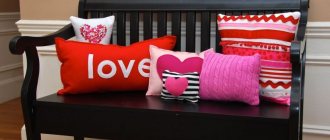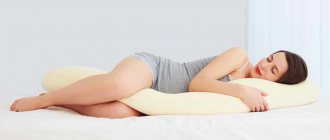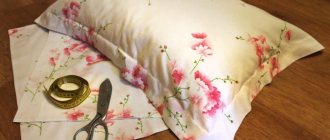At what age does a child need a pillow?
Young parents often try to prepare a beautiful soft pillow for their newborn baby and create, in their opinion, a comfortable and cozy environment in the stroller and crib.
This decision is absolutely wrong. What kind of pillow does a child need, and at what age should one be purchased?
In the first two years of life, a child does not need a pillow at all. The still unformed spine should be on a flat, hard surface. The pillow will contribute to its curvature in the area of the cervical vertebrae. In addition to problems with the spine, the baby may simply suffocate if he turns face down on the pillow.
There are anatomical pillows that completely follow the configuration of the child’s body, but there is still serious debate about their benefits. Experts have not yet found serious evidence of this fact. The need for their use is determined by medical indications and only on the recommendation of a pediatrician.
Does my child need an orthopedic pillow?
There is no consensus on whether a child needs orthotics. pillow. Some pediatric specialists firmly believe that you can be content without this accessory. If absolutely necessary, use a folded flannel diaper instead. This is explained by the fact that when sleeping without a pillow, overstrain of the cervical spine will not occur and will not lead to curvature. There is also a scary argument: an increased risk of strangulation.
Some pediatricians believe that orthopedic pillows for children are beneficial in creating the right conditions for the development of the newborn’s spinal region. It is for those who adhere to the use of this element that manufacturers produce special children's anatomical pillows.
But despite the divergence of two opinions, doctors are unanimous in one thing: an orthopedic pillow is not needed for children under one year old. Newborns have proportionately larger heads than adults, so it is more convenient for them to sleep without a pillow. They can roll off it onto the flat surface of the mattress or be thrown out of their sleeping place altogether. But as with any rule, there are also exceptions, in which case orthopedists and pediatricians recommend using a pillow for the baby. Sometimes the baby just likes to sleep on it. In such cases, it is necessary to be careful and approach the choice of this accessory with full responsibility.
Rules for choosing a pillow
At two or three years old, when you can already buy a pillow for your child, you can think about buying it. You should remember about the orthopedic properties that it should have. The pillow should be:
- flat;
- low, ideally no more than 3 cm;
- medium hardness: the head should be well supported;
- small size, fits the width of the crib.
The best pillow for a child aged 2 to 7 years has a size of 50x40 cm. Its height does not have a strict standard and depends on the width of the shoulder, optimally from 2 to 10 cm. Accordingly, the older your son or daughter, the higher this figure.
Children over 7 years old can purchase an “adult” version of the pillow measuring 60x40 cm. The height is also selected individually.
It is important to choose a pillow with a special orthopedic configuration, that is, it should have a supporting cushion under the neck and a recess under the head. Only with this shape will the child’s spine be straight during sleep, both in the position on the back and on the side.
When do you need a pillow?
This item is needed for a child over 1 year old or a 2 year old . Until this age, pediatricians do not recommend using such a thing at all. But an exception may be a doctor’s prescription for some diseases.
There is no clear answer to the question of when to start placing a pillow under a child’s head. Each parent solves this problem individually, depending on the psychological and physical development of the child.
Most often, this item begins to be used at one and a half years , when natural curves begin to form in the spine.
If a child categorically refuses to sleep on a pillow, then he cannot be forced. If the baby's head slides off the pillow or he throws it out of the crib, this means that the product is not suitable for him. In this case, you will have to experiment and choose something that will be comfortable for the baby.
Which filler should you prefer?
Filling is another important detail that it is recommended to pay attention to when choosing a pillow. It is made from various types of raw materials, that is, it can be natural or synthetic, soft or elastic, and has its own advantages and disadvantages. For a “correct” pillow, these indicators are in the optimal ratio and depend on the age of the child. It doesn’t matter whether you decide to choose a pillow for a child from the age of three or equip a sleeping place for a teenager, remember that natural ingredients can be allergens, and artificial ones are not always harmful to health. In the latter case, it all depends on the manufacturer.
Pillows with natural fillings
Natural fillers include fillers made from natural materials: fluff, sheep wool, latex, and parts of plants processed in a certain way.
It is traditionally believed that natural fillers are better than artificial ones, but they also have their drawbacks.
Down pillows
Pillow based on swan down Lonax Blu Ocean — 900 rub.
Down pillows have always been considered one of the most expensive. They are soft, quite elastic, easily take the shape of the head during sleep and also quickly restore their configuration. Down has excellent thermal insulation and hygroscopicity, which creates comfortable sleeping conditions in any weather. Pillows made of this material are lightweight and do not produce noise during operation.
One of the disadvantages is the need for careful processing of the down. A pillow made at home or in production, but with a violation of technology, will become a real breeding ground for dust mites that cause allergies. The softness of these pillows made them a no-no for young children whose spine has not yet fully formed.
Sheep wool pillows
Sheep wool is the second most popular natural filling for children's pillows. It, like down, has excellent breathability, hygroscopicity, and low thermal conductivity. Do not forget about its healing properties, thanks to the lanolin content in it.
Disadvantages also include the need for complex, multi-level treatment to avoid allergic reactions to dust mites. Wool quickly mats and becomes unusable. Soft pillows are not recommended for small children or people with spinal problems.
Natural latex pillows
An example of a pillow with natural latex granules: Promtex-Orient Lades - 1,800 rubles
The natural latex used in baby pillows is a solid piece of foam-like material with special holes made for ventilation. It has an orthopedic effect, hypoallergenic properties, is easy to care for, has a long service life and does not make noise during sleep.
This material has practically no disadvantages. An exception may be a possible allergy to latex (which is extremely rare), a specific smell of a new product (which also depends on the manufacturer) and high cost.
Pillows with natural plant fillings
Vegetable fillers have become more than popular recently. And this is not only latexed coconut coir, but also buckwheat husks and medicinal herbal mixtures.
These materials are hypoallergenic, and the herbal mixtures are also aromatic. They are well ventilated and have hygroscopic properties.
The disadvantages include a fairly high degree of rigidity, but for young children this fact can be considered more of a plus. Vegetable fillers, except coconut impregnated with latex, make a lot of rustling noise during use, which can bother children. When talking about coconut, it is worth mentioning the high price, but its quality is worth it.
Natural fillers
By the age of 4, my daughter managed to change 2 pillows. The first one is very low with synthetics, the second one has been with her for a year already, on felt swan down. Elastic, but when we bought it, it was very big. I liked that there was a zipper on the side, I took out half of the fluff. Convenient option, you can adjust the height.
Of course, in too hot weather the head sweats. But what can you expect from synthetics then? And among natural ones there are also those that do not cause allergies. For example, buckwheat husk.
Buckwheat pocket
The most popular type today. The pad can be of the most ordinary shape, but with the help of the husk an orthopedic effect is achieved. This headrest adapts to the contours of the neck and head, ensuring healthy and sound sleep for children. The main thing is to keep the dimensions correctly.
They say that there are no germs in this. But I have little faith in this. Although microbes may not start. And the bugs are just right. Ask the seller what kind of processing the product went through. There is another minus - rustling. But it depends on the quality, and therefore the price. It has been noticed that the more expensive the product, the less it rustles. If your baby is ready to get used to this, or his sleep is so sound that he won’t notice the deficiency, buy it. This is also an amazing massage! You won't find a better option!
Our pad can increase in size. Perhaps there’s no need to change anything, just add some fluff, that’s all. Up to 5 years is enough for sure! But I’ll probably try this material too. What do you think about this filling? Does the rustling bother you? Then a few more variations!
Pooh
If you choose this content, ask for certificates. There must be treatment for parasites and allergies. Many will be embarrassed. What then is naturalness? If there is a certificate, it means the treatment was gentle and not capable of harming the baby. Or take care of it yourself. I steam at least once a month. I wash my pillowcases all the time.
The down itself is comfortable and light. This is not the feather that was there before and was constantly pricked. The material is dumped. In appearance it resembles pieces of padding polyester. But tactile sensations confirm naturalness. Soft but resilient. Keeps its shape well.
Sheep's wool
Provides excellent air exchange. This foundation is called anti-stress; it can normalize good sleep. The baby will be comfortable here. The head will not fall, but will take a comfortable position. But there are downsides. Firstly, it causes allergic reactions. Secondly, it falls off quickly. To increase service life, manufacturers mix sheep wool with an artificial base.
Latex
Hevea tree sap. I was amazed that the basis is natural, but there is no place for bugs and worms. Latex adapts to the contours of the body, providing excellent sleep. It is believed to have a memory effect! This is a durable material. Mainly used for the manufacture of specialized medicinal products. But there are also regular square latex-based pillows on sale. It is clear that these are more expensive. But the quality is corresponding.
Lyocell
One of the latest inventions. It is recycled eucalyptus pulp. It looks like a padding polyester, only more airy, elastic and does not fall off. Long lasting. Surely you think that germs and bugs will quickly appear in such a place? You guessed wrong! This is eucalyptus, the bactericidal properties of lyocell are also preserved.
This type of base will retain heat well. I immediately remember the frosty winter! But it won’t be hot here in summer either; lyocell provides good air exchange.
So among natural ones there are harmless ones. You just need to choose. What did you like? Which option would you like to try? I'll probably leave it as it is. I'll just add some filler. And I’ll buy a headrest with buckwheat husks! And you? Leave comments! And become blog subscribers. See you again!
Pillows with synthetic fillings
Synthetic fillers: foam rubber, synthetic winterizer, polyurethane foam, holofiber - are no less popular than natural ones. For children, they are more suitable than natural ones, as they do not cause allergic reactions.
Among their advantages we can immediately name the affordable price. At the same time, manufactured by reliable manufacturers, they are not inferior in quality to natural ones.
Pillows with foam rubber and padding polyester
Foam rubber and synthetic winterizer are some of the most budget-friendly fillings for children's pillows on the market. In addition to the low price, the materials themselves do not cause allergic reactions, are hygroscopic, are well ventilated, and do not require complex care.
One of the disadvantages is the short service life: foam rubber loses its elastic shape, and synthetic padding falls off. Plus the ability to absorb moisture and dust makes them dangerous for children with allergies.
Polyurethane foam pillows
Example of a memory-based pillow: Promtex-Orient Memory - RUB 2,400
Polyurethane foam or artificial latex, memory are popular fillers for children's pillows with an orthopedic effect. The material is moderately soft and perfectly supports the head and neck in the correct position, which is especially important for children whose musculoskeletal system has not yet fully developed.
The disadvantages include a short service life, although it is much longer than that of foam rubber or padding polyester. This quality criterion is naturally reflected in the cost of the product. Another advantage of memory filler is the ability to perfectly follow the contours of the head during sleep.
Holofiber pillows
Like all synthetic materials, holofiber does not cause allergies, is well ventilated, and has moderate rigidity, which is good for children. During sleep, this filler does not make noise, is comfortable and cozy.
The problem with the disadvantages is the same - short service life. Considering that children grow quickly and in two or three years they will need a new, larger pillow, this minus can be considered not critical.
How to choose a pillow for a child?
When purchasing, it is important to make sure that the bedding meets three requirements:
- Orthopedic effect. This means that the baby pillow maintains a healthy position of the spine: the head does not fall back, the neck is not tense. The child should lie on his back, and if the bedding is chosen correctly, the spine will take an anatomically correct position. Thanks to the orthopedic properties, healthy posture is formed, the baby gets a good rest during the night.
- Hygiene. The materials from which bedding is made must be breathable, easily absorb moisture and not contribute to the accumulation of dust. Look for a baby pillow made from materials that do not cause allergic reactions. Babies are sensitive, their immunity reacts sharply to irritants.
- Moderate hardness. Soft down pillows are not the best choice for a baby. The surface must be elastic, a little hard, so that the head does not fall into the soft material, otherwise the anatomically correct position of the spine will not be achieved.
General rules for choosing a baby pillow
When deciding which pillow to choose for your child , it is recommended to consider a few tips that you should follow when purchasing.
- The height of the pillow should correspond to the width of the child’s shoulder, without exceeding it. The spine should maintain a horizontal position during sleep.
- The size of the pillow should match the size of the bed.
- The degree of hardness for children is recommended to be moderate.
- It is recommended to purchase pillows with natural fillings, primarily down, from trusted manufacturers who guarantee special processing of the material. It should be remembered that after five years of use the impregnation stops working and the pillow will have to be replaced.
- You should pay attention to the quality of the seams and the absence of unpleasant odors.
- It is recommended to purchase orthopedic pillows only after consulting a doctor.
